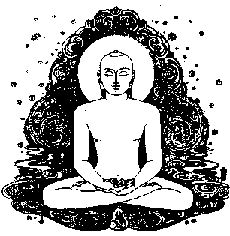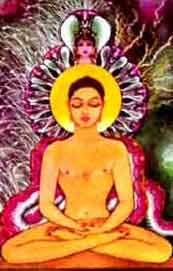|
Bhagwan Adinath is
considered as the Adipurush, the first Tirthankara and first ruling
King. Born in the royal family of Ayodhya as the son of King Nabhiraja
and Queen Maru Devi, He was married to Sumangla and Sunanda. Sumangla
gave birth to Bharat, who later became a Chakravarti king . Sunanda
gave birth to a child who came to be known as Bahubali.
 It is believed that
Adinath had one hundred sons and two daughters, who were named Brahmi
and Sundari. Jain tradition holds that all civilization developed from
the teachings of Adinath. He was the first king to establish the
institutions of marriage, agriculture, the arts, and weaponry
(swordsmanship, archery, etc). After organizing and instructing the
society in various disciplines, he ruled for thousands of years. It is believed that
Adinath had one hundred sons and two daughters, who were named Brahmi
and Sundari. Jain tradition holds that all civilization developed from
the teachings of Adinath. He was the first king to establish the
institutions of marriage, agriculture, the arts, and weaponry
(swordsmanship, archery, etc). After organizing and instructing the
society in various disciplines, he ruled for thousands of years.
After this, he
divided his kingdom among his sons and departed to take up an ascetic
way of life. When Adinath renounced his kingdom, thousands of people
followed him into the ascetic life. Whenever they went for alms,
people offered them gold, jewels, ornaments, etc. But no one offered
them food. Thus, many of his followers could not tolerate the
starvation. They began asking for food, and then they left to form
their own groups. This was the beginning of many sects. (According to
the Jain faith, Tirthankaras remained silent until they achieved
perfection.)
Adinath also went
without food for an entire year. Then he went to his grandson Shreyans''
kingdom (Hastinapur). His grandson offered him sugarcane
juice, which he accepted. Hastinapur is still considered a holy place,
and even today Jains make pilgrimages to this site to break ritual
fasts (with sugarcane juice). After becoming enlightened (Perfect), He
broke his silence and preached for many years, telling how to escape
the cycle of birth and death and achieve eternal bliss. Bhagwan
Adinath achieved Nirvana on the mountain of Kailash in the Himalayas
when he was in complete Samadhi. The symbol of Adinath is A Bull (Rishabh).
He became popular by this symbol and is now known as Rishabh Dev.
Bhagwan Chandra Prabhu
The eighth
Tirthankar of Jainism is Chandra Prabhu. He was born to King Mahasen
and Queen Sulakshana. When the Queen was bearing the child, she
desired to swallow the nectar of the moon. Her wish was fulfilled and
a son with a moon-like complexion was born to her. This is how he was
named Chandra Prabhu. He got married to more than one princess. After
ruling his kingdom for a long time, he got initiation (Diksha).
Chandra Prabhu attained Kaivalya after meditating for many months. For
many years he served humanity. Then he went to 'Sammed' Mountain in
Bihar, accompanied by one thousand monks. After meditating for one
month, all of them got Nirvana.
Today, the temple
of Chandra Prabhu at Tijara in Rajasthan is a famous center of
pilgrimage for Jains. Symbol of Chandra Prabhu is half moon. He brings
smoothness and happiness to every living being. Large numbers of
believers visit the tirth of Tijara every week.
Bhagwan Shantinath
The sixteenth
Tirthankar of the Jain religion, Shantinath, was born to the King
Vishavsen and Queen Achiradevi of Hastinapur. It is said that as soon
as he entered the womb of his mother, incurable diseases were cured,
and peace and happiness prevailed throughout the land. Because of
this, he came to be called Santinath ('peacemaker'). When
Shantinath was very young, he became expert in the use of many
weapons. These skills enabled him to become a king at a very young
age. Eventually, he became known as Chakrarvarti ('King of Kings').
He enjoyed his
kingdom and its riches for thousands of years. One day, however, he
saw his own aging reflection in a mirror and realized that this body
was not as young and beautiful as it used to be. Thus he came to
realize that all the riches and even man's body itself are not
eternal. At that moment he was inspired to become an ascetic.
He became
enlightened on the eleventh moonlight night of Paush (Feb-March). For
many years he traveled from city to city, spreading the message of
peace, non-violence, and harmony. Finally, he achieved Nirvana on the mountain
of Sammed Shikhar (Bihar). His symbol is a deer (Mriga). He
is considered a god with powers to bestow peace and happiness.
Bhagwan Parshvanath
According to Jain
belief, Bhagwan Parshvanath is the twenty-third Tirthankar. He was
born 250 years prior to Lord Mahavir. He was the son of King Ashvasen
and Queen Vamadevi of Varanasi. It
is said that he was named Parshvanath after an incident his mother
experienced when the child was still in her womb. The mother found
that a snake was lying next to her. Parshva means 'by the side of' --
hence the name Parshvanath.
 Young Prince
Parshva grew up as a great scholar and warrior. He married the
daughter of Raja Prasenjit, Kumari Prabhavati. When their kingdom was
attacked by another king (Yavanraj), Parshva asked his father for
permission to fight. He then defeated Yavanraj not by armed fight but
by intellectual discussion. Impressed by the scholarly discussion of
Parshvanath, Yavanraj became his follower. Parshva forgave him and
inspired him to adopt non-violence. Young Prince
Parshva grew up as a great scholar and warrior. He married the
daughter of Raja Prasenjit, Kumari Prabhavati. When their kingdom was
attacked by another king (Yavanraj), Parshva asked his father for
permission to fight. He then defeated Yavanraj not by armed fight but
by intellectual discussion. Impressed by the scholarly discussion of
Parshvanath, Yavanraj became his follower. Parshva forgave him and
inspired him to adopt non-violence.
Once Parshva went
to a ceremony, 'Panchagni Tapa,' performed by Kamath. Parshva
discovered a cobra couple in the firewood and saved their life. With
the help of 'Namokar Mantra,' Parshvanath sent the cobras to heaven.
His action angered Kamath, who thought Parshva had disturbed his holy
life. Kamath, who later became Meghmali, created many obstacles to
Parshvanath's meditation. He flooded the place where Parshvanath was
deeply engrossed in austerity. Then the Cobra Couple (who were now
Dharmendra and Padmavati) raised a Lotus Seat below the meditating
Parshva and thus saved him from drowning.
For the noble work
done by Dharmendra and Padmavati at Sammed Shikhar (Bihar), Jain
followers worship them as a God and Goddess. According to history,
Bhagwan Parshvanath got Nirvana in 720 B.C., after attaining Kaivalya.
Twenty-three monks accompanied him. His symbol is snake; and he lived
one hundred years. He is worshipped by all the sects of Jainism with
equal faith and respect.
Bhagwan Mahavir
The last
(twenty-fourth) Tirthankar, Mahavir, was a historical personality. He
was born in 599 BC at Kshatriya Kund in the democratic republic of
Vaishali (Bihar), the son of King Siddharth and Queen Trishla Devi.
His original name was Vardhman. From
his childhood, he was soft, kind-hearted. He was very upset by the
ritual sacrifice of animals, and vowed to fight for the rights of
animals. He also wished to fight for the advancement of women and
untouchables.
He left his kingdom
at the age of thirty to begin an ascetic life. He entered the forest
to commune with all living beings, including animals, trees, and other
plants. He practiced meditation, austerity, and samadhi for twelve and
a half years, getting enlightenment. By self-purification and severe
spiritual practices, finally, at the age of forty-two, Mahavir attained
Kaivalya (perfection).
For the next thirty
years, Mahavir spread the message of non-violence (Ahimsa), truth,
non-stealing, right conduct, and non-possession. He campaigned against
the barriers of caste, creed, and faith. He also advocated protecting
all living creatures. Bhagwan Mahavir gave us several analytical
theories of Karma, multiplicity of truth etc. All these
theories helped people to reach higher levels of consciousness and to
create happiness and peace in society. His doctrines of Right
Knowing, Right Vision, and Right Conduct are considered the three
Jewels of Jain philosophy, by which to achieve the ultimate goal in
life.
The symbol of Lord
Mahavir is the Lion, indicating what a fearless life he led. He is the
most important of all the Tirthankaras, as most of the Jain scriptures
were taken from his teachings. He advocated Ahimsa, which was carried
further by later great men of history including Mahatma Gandhi and
Martin Luther King. Mahavir attained Nirvana at the age of seventy-two
at Pavapuri in Bihar.
Bhagwan
Bahubali
Bhagwan Bahubali is
not a Tirthankar, he was, in fact, the younger son of the first
Tirthankar, Rishabhdev. He later became king of Podanpur. His elder
brother Bharat was bent upon attacking Bahubali's kingdom. Their
ministers negotiated and agreed that instead of war, there would be
three contests between the brothers. In all three contests (Drisht
Yudha, Jal Yudha, and Wrestling) Bahubali defeated his elder brother.
Still, Bahubali had
been very much hurt by the behavior of his elder brother. He decided
to surrender his kingdom to Bharat and left for the path of
meditation. He did not want to bow before his other brothers who had
already accepted ascetic life. This ego of Bahubali deterred him from
visiting his father's court. Hence he went on meditating but could not
attain the Keval Jnana, the supreme knowledge.
Bahubali was so
much involved in his Samadhi, that his body got covered by vines,
ants, and dust. Finally he was woken up from his ego when his sisters
called him to release the false pride he was suffering from. Bahubali
got enlightened and decided to see his father. Thanks to his sisters Brahmi
and Sundari, Bahubali was now a changed person with more
knowledge and better understanding. He was welcomed in his father's
court. The world got the benefit of his wisdom.
Bahubali is a
symbol of learning. One stone statue of him in Karnataka stands
fifty-seven feet high. For thousands of years it has shown to the
world the way of knowledge and austerity.
 Move back to
previous page on Tirthankaras <<
Move back to
previous page on Tirthankaras <<
|